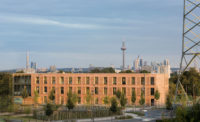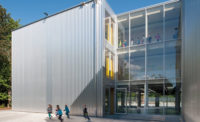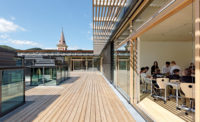In 2011, two Swiss towns on the western shore of Lake Zurich, Rüschlikon and Kilchberg, decided to construct a shared public school for grades seven through nine. Rather than building separate facilities, they pooled their resources in hopes of increasing staff and creating a single building at an elevated level of design that would enhance the learning experience with flexible spaces. “When institutions merge, the usual motivation is to save money,” says Lorenz Felder, a parent and president of the association overseeing the new facility, “but we wanted to improve the quality of the education— this was the driving force.”
Additional Information:Jump to credits & specifications
Situated among single- and multifamily residences in Rüschlikon, the school, named Campus Moos, opened in September 2016. It occupies a site planned by Zurich-based architects Jakob Zweifel and Heinrich Strickler with landscape architect Ernst Cramer in the late 1960s. The team had proposed shops, a residential tower, a primary school, and a row of plane trees along the site’s northern and western boundary, yet only the school was built and the trees planted. Taking part in a limited competition in 2012, E2A architects, also Zurich-based, returned to this scheme and placed a compact six-story middle school for 164 pupils next to the primary school, where the residential tower had been envisioned, thus preserving the mature trees and the neighboring play area.
To educate a diverse student body (half the children are foreign-born), Campus Moos emphasizes sports and performing arts. Skill-building through personalized assignments, collective projects, and differentiated instruction according to ability are offered across disciplines. Addressing these various approaches required a range of spaces whose uses might shift over the course of the day.
The architects rejected the typical rigid, classroom-based Swiss school layout, opting instead for a design with fewer predetermined spaces. “Children learn a lot from one another, and this school needed to help students engage with their peers,” says E2A partner Wim Eckert. The architects’ scheme developed as a large cube constructed of reinforced concrete.
Seven floors are stacked to a height of 82 feet. Fenestration alternates from level to level, between long ribbons of floor-to-ceiling triple glazing and a single large window, creating a rhythm on the facades and varying the light levels and views for occupants. The opaque sides are structural, and the building’s corners carry point loads. Circulation and sanitary cores occupy the plan’s northwest and southeast corners, leaving a largely unencumbered interior.
Although the ground floor, holding the cafeteria and a performance area, has an open plan (it can be divided by deploying a sliding wall), more conventional spaces are found in the half-sunken basement, containing music rooms and workshops, and on the second level, where administrative offices and the library are located. On levels three to six, plans are organized into three parallel bars, providing the greatest flexibility. A concrete spiral stair sits at the center of the middle bar, with the spaces to either side accommodating informal learning activities. The other two bar-shaped spaces hold classrooms and a larger “learning atelier,” which can be split into two smaller classrooms with sliding partitions. Level five, with the same layout, contains kitchens, laboratories, and therapy rooms.
Exposed concrete interiors might seem inappropriate for a school. “Some people would like it to be more colorful,“ says Felder. Yet the advantages of the material are experiential and atmospheric. From within, the fine-grained concrete gently reflects both natural and electric illumination and suggests a place “like a museum or an artist’s studio,” says school principal Conny Christen. In addition to concrete, the architects specified neutral finishes, such as matte white fiberboard for sliding walls and storage units, pearl gray terrazzo flooring in the public areas, and oak floors in the classrooms. The muted colors of the walls and floors cause these surfaces to fade into the background, instead highlighting occupants and their activity. With a similarly deft hand, the team tucked acoustic panels, ducts, and LEDs between the ribbed ceiling’s exposed concrete beams to create a clean plane.
Selecting concrete for the principal material had other advantages— its thermal mass allowed for reduced heating. Other sustainable strategies include operable fenestration (which eliminates the need for air-conditioning) and a geothermal heat-recycling system that Campus Moos shares with the primary school.
One might not expect such a rationally planned building to enliven the daily experience at a small, suburban school. Yet Campus Moos’s concrete form and extensive glazing feels surprisingly inviting, while its generous multipurpose spaces provide ample opportunities for pupils to engage one another. Although students and staff are still testing the waters, architecture’s ability to enrich school life is already in evidence here. “The 40 ninth graders like working together in the sixth-floor learning atelier,” says Christen. “They are quiet and listen to one another; the space gives them the sense of community.”
CreditsArchitect: E2A, Piet Eckert und Wim Eckert Architekten ETH BSA SIA
Personnel in architect's firm who should receive special credit: Wim Eckert, Piet Eckert with Nils Döring and Eric Rudolph, Oke Hauser, Andrea Kovács, Kirstyn Lindsay, Valentino Sandri, Tobias Weise
Associate architect: Nils Döring
Engineers Dr. Lüchinger + Meyer Bauingenieure AG, Zurich, Switzerland
Consultants BB&A Buri Bauphysik & Akustik AG, Volketswil, Switzerland
General contractor: E2A, Piet Eckert and Wim Eckert Architekten ETH BSA SIA, Zurich, Switzerland
Photographer: Rasmus Norlander AND Kuster Frey
|
SpecificationsKitchen (fifth floor) Simeta AG Gnadenthalerstrassse 2 CH-5524 Niederwil
School furnishings Embru-Werke AG Rapperswilerstrasse 33 CH-8630 Rüti
Elevator system Schindler Aufzüge AG Zugerstrasse 13 CH-6030 Ebikon
Glass Partition Walls Jegen AG Moosburgstrasse 5 CH-8307 Illnau-Effretikon
Stage equipment Schelling AG für Bautechnik Lindenmoosstrasse 6 CH-8910 Affoltern a.A.
Ventilation System Rokitzky AG Winterthurerstrasse 284 CH-8057 Zurich
Windows and external doors Diralsa AG Seestrasse 18 CH-5432 Neuenhof
Locking system Evex AG Im Schörli 3 CH-8600 Dübendorf
Ceiling cladding – wood and metal Röösli AG Allmendstrasse 20 CH-8320 Fehraltorf |

















